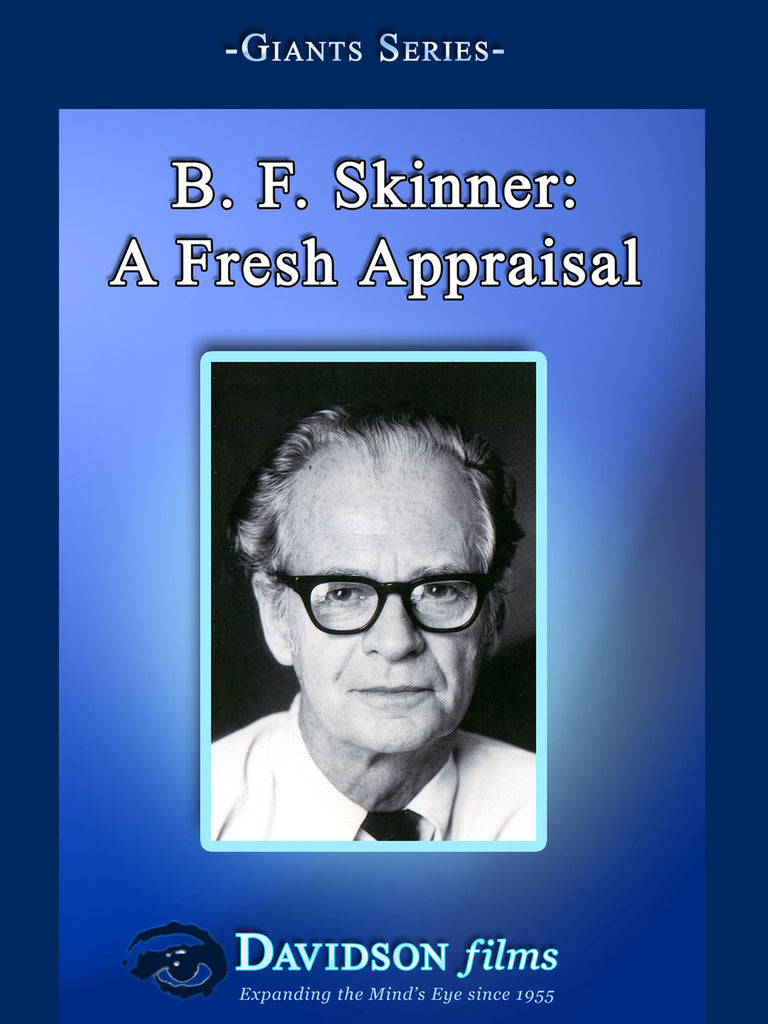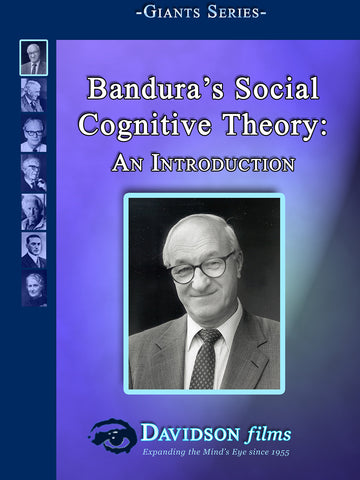B. F. Skinner: A Fresh Appraisal With Murray Sidman, Ph.D.
Institutional DVD price: $ 250.00
Description
Other than Freud, no psychologist has been so discussed, critiqued and, at times, maligned as B.F. Skinner. Using both archival and new film, this video takes a new look at who the man was, and what he really said in his twenty books. Like other thinkers who broke new ground, Skinner had to invent his own vocabulary to describe the phenomena he was studying. In this film, his terms are introduced in context so the student understands how they were intended to be used and the research that produced them. The film lays to rest some myths and credits Skinner with contributions not often attributed to him.
Understanding the complex man behind his work enables students to better evaluate the importance and relevance of the work he inspired. Murray Sidman, Ph.D., colleague and thoughtful practitioner of behavioral analysis, narrates.
Preview
Learning Guides
Discussion Topics
Reviews
"The narrator, Dr. Murray Sidman, settles into a chair in a comfortable room lined with bookshelves and knick-knacks and refers to his notes about the life and work of Burrhus Frederic Skinner. Sidman refers to the influences of Darwin, Freud, and Pavlov on Skinner’s work involving operant behavior and the science of behavior analysis of humans as individuals and within social systems.
"Skinner’s fascination with mechanical apparatuses led him to 'gadgeteering,' the creation of devices for experiments with both lab animals and humans. The famous Skinner box was a closed environment invented for demonstrating that the repetition of any activity that produced consequences (reinforcers) showed that behavior is governed by consequences. Another famous gadget, the 'Teaching Machine,' was based upon positive reinforcement in the learning environment.
"The highlight of the film is the segment featuring Skinner’s daughters, Julie and Deborah, discussing the famous 'Baby Box,' for which there was great public outcry. As Julie describes, her mother wanted help with tending to baby care with the birth of second child, Deborah. The baby box, or Aircrib, was Skinner’s way of providing a warm, safe environment for sleep and playtime for the baby. The public associated Skinner’s lab experiments with animals and the closed environment of the baby box; depicting Skinner as a cold and mechanical parent. The women share fond memories of their father, and show his simple basement study area complete with a magnifying device strung up with fishing wire over his desk to accommodate his failing eyesight.
"Sidman presents an excellent blend of Skinner’s life and work and brief discussion of his major books, The Behavior of Organisms: An Experimental Analysis, Verbal Behavior, and the novel Walden Two. Skinner’s aim to improve human life through the application of behavior analysis comes through clearly in the film.
"Recommended — particularly for college students in Psychology.”
-- MC Journal: the Journal of Academic Media Librarianship
“This video begins simply and exquisitely with Fred skinner telling us about the damned rat not doing what he is supposed to do. In the first few lines, I learnt something new; I had not known that this famous quotation was a psychological illustration of the secret of success in all scientific investigation. The only trouble in the scene occurs immediately while the audience is still settling in. My audience wanted it replayed. So, did I.
"The stage is perfectly set. It grabbed the attention of the six groups of psychologists and friends who watched the video with me. It was evident from watching them that their attention was sustained. In their words, the video was 'absorbing throughout.' 'If you didn't know that he had done that...' (designed teaching machines for example...), 'I wish I had shown this when we were trying to learn this stuff.' 'An amazing man!'
"In many respects, perhaps in every respect, the video is old-fashioned. It starts in the beginning with Skinner as a youth in a small town and ends with Skinner's APA Award presentation just a few days before his death in 1990. It's serious about presenting its subject matter. The script is very carefully crafted and read by Murray Sidman so as to achieve clarity with some difficult concepts. Aside from occasional unobtrusive piano background music, there are no sound effects, no special effects. For some, these aspects may be a drawback, but to me, they are all in keeping with presenting the work of a man who wanted to be remembered by his accomplishments. I think Fred Skinner would have very much appreciated hearing and seeing his work presently clearly and correctly. The purpose of the film is to set the record straight and that it does.
"The video begins with snippets of Skinner's youth and then places his ideas in the context of Darwin, Freud and Pavlov. Darwinian natural selection of species characteristics was, of course, extended by Skinner to selection of behavior by consequences in our lifetime. The similarities between Freud's and Skinner's belief in the causation of human behavior and the important role of early experience are pointed out. Usually, we hear only the differences between concepts and contributions of these two men. Pavlov's more familiar work with conditioning salivation to the sound of the metronome provides the base to explain the important distinction between Pavlovian S-R conditioning and operant or R-S conditioning. This section is very nicely done with memorable footage of shaping a pigeon to ring a bell. The concept of discriminative stimulus is described to finish off the three-term contingency. Skinner’s opposition to the use of punishment is stated unequivocally.
"The concepts are punctuated by interesting applied and laboratory illustrations with people and other animals. The final portion by way of a summary shows more applications with particular emphasis on language education. As good as these examples are, all of the people examples are with children. This decision is understandable insofar as the video is about B.F. Skinner and he, himself, only applied contingencies of reinforcement to education, i.e., programmed instruction and teaching machines. That's not quite true, however, in that he also, among other things, invented the cumulative recorder, designed an air crib for his daughter, and other contraptions to enhance his productivity. Incidentally, it was great to listen to his daughters, Julie and Debbie, talking about their father and the ‘baby box.’
"When I first heard that Davidson Films was doing a video on the life and work of Fred Skinner to fit within the standard 50 minute lecture hour, I wondered how it could be done. Well, they have shown me. Ina stimulating 41 minutes, they have captured the accomplishments of this 'amazing man.' Be warned, however, that you may well want to watch it again."
-- Jay Birnbrauer, Senior Fellow, Cambridge Center for Behavioral Studies, Associate Professor, Murdoch University, Perth, Western Australia





